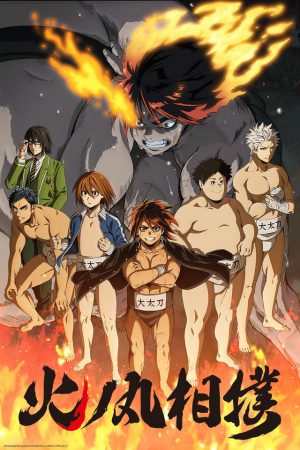
With all the sports anime/manga available, it’s very rare we get to see one based on sumo wrestling, a traditional Japanese sport. To some non-Japanese people, it’s understandable to see it as ridiculous with its competitors being obese as they charge at each other wearing nothing but sashes (or mawashi). Thanks to the recent broadcasting of Hinomaruzumou, it provides international audiences an educational look into how sumo works.
Hierarchical Structure
Though some Westerners aren’t exactly keen on a hierarchical structure in a general sense, sumo’s system lives by it. While Hinomaruzumou focuses on the sport at a high school level, it still finds time to highlight how it works on the professional stage as well. While we can’t exactly speak for how the dub portrays the terminology, all sumo wrestlers in the Japanese language are referred to as rikishi (力士, the first kanji means “strength” and the second means “warrior”), and there are numerous divisions/rankings in which a rikishi can compete in. The bottom four divisions are jonokuchi, jonidan, sandanme, and makushita.
Once a rikishi becomes top 70, they are referred to as a sekitori and the best 42 are known as the makuuchi, the cream of the crop. When a rikishi becomes a champion, they earn the title of yokozuna, a name that was popularized by Rodney Anao’i (who happens to be a cousin of Dwayne “The Rock” Johnson), a 1990s Samoan professional wrestler who took the persona of a sumo wrestler even though he never had any background in it (though his other relative, Haku, did). As we see in the anime, Hinomaru and his rivals wish to become a yokozuna at both the high school and professional level.
When you see Odachi High School train at a stable in Nagoya, you further see how the stable hierarchy works. Certain rikishi of certain ranks can’t train with higher ranking rikishi unless they’re given permission by the oyakata (the boss of the stable) or another high ranking member. A mawashi, or a belt that a rikishi wears comes in two colors, black and white. Rikishi that are of makushita ranking or below wear a black mawashi in competition and in training, while rikishi of sekitori rankings wear a white mawashi.
High School Sumo
As you can see in the anime, sumo is portrayed at the high school level and you’re probably asking yourself if high schools in Japan actually do have sumo program. We can confirm (first hand) that this is true though by no means is it available in every high school throughout the country. While professional sumo does have a lot of rule in regards to height requirements (which happens to be true) and how one can tie their hair, these rules are relaxed at the high school level, which is portrayed through the Hinomaru character. It is true that if a high school students wins the equivalent to being a yokozuna at that level, he can get an exception to the 167cm height requirement.
Diet
If you think sumo wrestlers eat whatever they want to get that fat, think again! Very early on in the series, you see the cast eat chanko nabe, which is also what real life sumo wrestlers eat to keep up their weight. Chanko nabe is a type of Japanese stew that uses chicken broth and is boiled with meat, vegetables and tofu, so they’re getting a lot of protein. If you ever visit the Ryogoku Kokugikan Sumo Stadium (which the series does portray!), you can actually try chankonabe there first hand (and watch actual sumo competitions)! Though obesity is a major concern, chanko nabe happens to be very healthy!
Competitive Rules
Finally, let’s get into the rules of sumo. As you probably have seen in actual sumo competitions and/or through the anime, the objective is to get your opponent out of the ring (or past a straw mat post) or throw them to the ground. This can either be done by pushing the opponent, using open hand strikes, or with throws and takedowns. Hinomaru tends to charge at his opponent like a football lineman to force his opponent down or out, Yuuma with his karate black belt naturally specializes in open hand striking and Kunisaki with his amateur wrestling credentials allows him to be flexible with his takedown techniques.
Through skinner rikishi such as Mitsuhashi, you can see that unlike boxing or MMA, there are NO weight classes in sumo! Though Mitsuhashi has yet to win in the anime (at least upon the drafting of this article), smaller rikishi can still use speed and agility to their advantage which is what he attempts to do.
As to the dohyo, or the ring, no matter what level of competition, it’s always a little over 4 ½ meters in diameter. One rikishi enters from the east, and the other enters from the west. Though this isn’t explained in the anime (probably due to Japanese audiences already familiar with sumo), the reason why a rikishi rises his legs as a warm up and throws salt into the ring is meant to be a “prayer” to the gods, and takes influence from Shinto (though the shrine above the dohyo is taken from Chinese culture). After finishing the opening ritual, both rikishi meet in the center of the dohyo and with closed fists, they must touch the ground before the referee can officially call the match. When the referee calls the fight, that is when the rikishi can start competing.
Final Thoughts
What we shared is simply just the tip of the iceberg as to how sumo is portrayed. We hope in the near future, we can share more information such as sumo naming conventions and why certain rikishi are referred to as “national treasures.” For now, we spend to focus on the training and competitive definitions to how sumo is portrayed in Hinomaruzumou.
Recommended Post
Sumo Anime Hinomaru Zumou Unveils 2nd Cours OP & ED
Recommended Post



